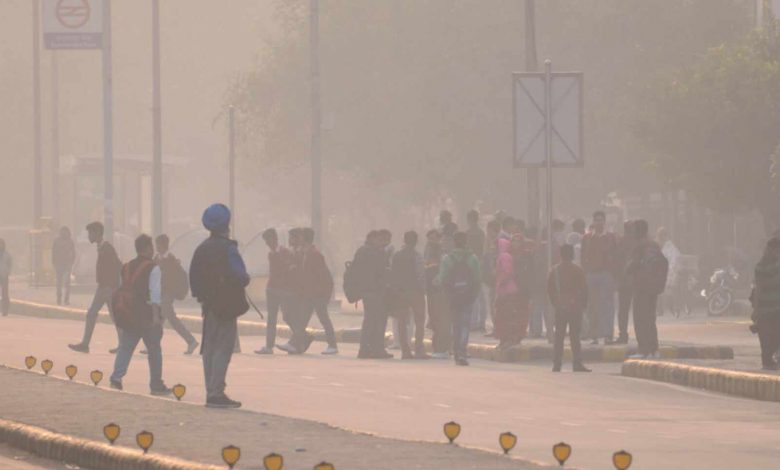Absence Of Winter Rains Keep Pollution Levels High In NCR & Northern Plains
For dispersion of pollution, cities need to cut down on emissions across sectors and at source

Air quality remains bad without winter rains. The Air Quality Index remains ‘poor’ even on the brightest days in Delhi-NCR, in the first half of December.
Even though the stubble burning subsided across the northwestern states of Punjab and Haryana after the Sowing of the rabi crop. The burden of high air pollution levels rests on emissions from sources like industrial activities, transport, regional pollution corridors, and prevailing weather conditions.
For dispersion of pollution, cities need to cut down on emissions across sectors and at source. However, weather conditions in the form of rains would bring some immediate relief but with increasing climate change these systems have also become inconsistent.
According to meteorologists, there has been an absolute absence of winter rains across the plains. In the wake of this, a stable wind pattern can be seen over the region and speed is also very slow. Minimum temperatures have been plunging continuously and settling in the range of 4°C-10°C. As the temperatures dip, cold north-westerly winds become heavier because of the increased moisture content. This also increases the capacity of the winds to capture pollutants close to the earth’s surface.
With unabated cold north-westerly winds reaching the plains, minimum temperatures will now drop and settle in single digits. With this, dispersing pollutants from the atmosphere would be very difficult. The more the minimum temperatures dip, thicker will be the inversion layer. And the thicker the inversion layer, it would be more difficult for sun rays or winds to penetrate through this layer and disperse the pollution level.
During winters, the air in the planetary boundary layer (the lowest part of the atmosphere) is thinner as the cooler air near the earth’s surface is dense. The cooler air is trapped under the warm air above that forms a kind of atmospheric lid. This phenomenon is called winter inversion. Since the vertical mixing of air happens only within this layer, the pollutants released lack enough space to disperse in the atmosphere.
Usually by this time of the year, the region witnesses at least one or two spells of winter rains and snowfall. However, due to the absence of any strong Western Disturbance (WD) up in the Himalayas, rains have been evading entire plains. While on and off feeble Western Disturbances have been visiting but they were not capable of triggering any significant weather activity.
According to the state run India Meteorological Department, November saw the passage of five WDs across North India. Out of these, two WDs (November 2-5 and 6-9) caused isolated to scattered rain or snowfall over Western Himalayan region and rainfall over adjoining areas. The remaining three were feeble (November 13-15, 18-21 and 22-24) located north of 30°N and did not affect the region.
Western Disturbances keep impacting the weather of Western Himalayas round the year. However, it is only by November, that intensity and frequency of Western Disturbances start picking up pace gradually. They also start travelling in the lower latitudes much closer to the hilly states, triggering the weather activities. Intensity and frequency is at the peak by January and February.
WDs govern the weather pattern over the North-western plains, especially during the winters. Arrival of a strong Western Disturbance triggers rain and snowfall across the hilly states and Indo-Gangetic Plains (IGP). It is only after the passage of this active system, which pushes icy winds across the plains, declaring the onset of the Winter season.
With the pattern missing this season so far, pollutants in the atmosphere are not able to clear up on account of no weather activity or change in wind pattern (increase in wind speed). Further in the IGP, the hub of winter air pollution, things seem to be getting worse with meteorologists predicting lesser rains in the remaining days of December.
“It is not only about the Indo-gangetic plains but most of the country saw air quality deteriorating. PM 10 was not the only contributor but carbon monoxide levels were also high. This shows construction activities were not alone but combustion was also high. Besides this, large scale meteorological phenomena like La Nina are also contributing by slowing down the circulations. We need more ‘Early Warning Systems’ to predict air quality. These systems could let us know what is the relative contribution of slowed weather systems,” said S N Tripathi, Professor, Civil Engineering dept, IIT Kanpur.
The PM 2.5 concentration in the capital city of Delhi was 183.38 ug/m3 which is three times higher than the Central Pollution Control Board’s daily safe limit of 60 ug/m3. Similarly, other cities like Ghaziabad, Kanpur, Gurugram, Sonipat all recorded PM 2.5 levels around double the safety limits.
In 2022, the Indo-Gangetic plains have been witnessing westerly winds from Rajasthan, instead of north-westerly winds from Punjab and Haryana. This was due to the absence of any weather system which could alter the wind pattern. Winter rains have also been deficit so far, keeping the temperatures above average across the region. Due to this, humidity levels were not very low, which were not able to trap the pollutants in the atmosphere. However, as temperatures dip and rains continue to be elusive in the region, the pollutants currently suspended in theair are less likely to be washed away any time soon.
The writer of this article is Dr. Seema Javed, a known Environmentalist, Journalist and Communications Expert




